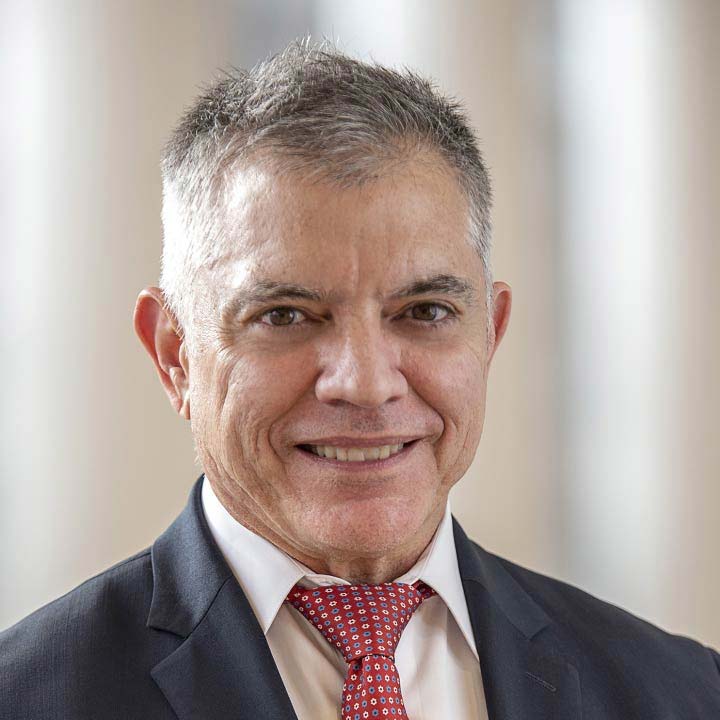
What is the skull base?
The skull base is the bone where the brain sits at the bottom of the skull. Many people use the analogy of a salad bowl to describe the area. The bowl has a hole at the center of the bottom where nerves, blood vessels and the spinal cord connect to the skull. That connecting area is located behind the nasal cavity where there’s a concentration of sensory tissues, arteries and nerves. The area is packed with crucial structures, making skull base tumors extremely difficult to access and remove.
What tumors affect the skull base?
Both cancerous and benign (noncancerous) tumors can form in the skull base, such as pituitary gland tumors. Very few skull base tumors are cancerous. Head and neck cancers account for 4% of all cancers in the body. Of those, .01% are located in the skull base.
What are the signs and symptoms of a skull base tumor?
There’s a wide range of symptoms depending on the type of tumor and location. For example, pituitary gland tumors can bring about hormonal changes and vision changes including a loss of vision as well as headaches. If a tumor is present in the nasal cavity, it can affect your sense of smell and ability to breathe. Other symptoms of skull base tumors can include headaches, hearing loss and nose bleeds.
What causes skull base tumors?
It’s unclear what causes some of these skull base tumors. Many patients never learn the cause. In other cases, known exposure to chemicals and radioactive substances are to blame. Those who work in woodworking are at higher risk from inhaling the wood dust. Some viruses can lead to tumors, including human papillomavirus (HPV) and the Epstein-Barr virus (EBV).
How are skull base tumors treated?
When it is determined a skull base tumor is cancerous, or when symptoms of the tumor affect the patient’s quality of life, surgery can be performed to remove the tumor. There are two types of surgery: traditional open surgery and minimally invasive endoscopic endonasal surgery. There are also nonsurgical treatments that can include radiation therapy (intensity modulated, stereotactic or proton), chemotherapy and immunotherapy.
Traditional skull base surgery is performed through scalp and facial incisions and include an open craniotomy, in which surgeons create an opening in the skull to access the tumor. The full recovery time for patients can take weeks. This is a surgery that works well for patients who have large and complicated invasive tumors that cross orbits and affect multiple arteries and organs.
How is minimally invasive skull base surgery performed?
A much less invasive approach that results in no facial scarring is endoscopic endonasal surgery. We were among some of the first surgeons in the world to pioneer this approach in the mid-1990s. This surgery works well for removing pituitary tumors and other growths that are at the center of the skull base. Using the nasal passageways as the entry point, tumors can be accessed using an endoscope equipped with a camera. A surgical navigation system uses images from an MRI or CT scan to help map out the patient’s anatomy to show the location of the tumor. This allows surgeons to identify structures in real time and use small surgical tools to access the tumor and remove it. Minimally invasive surgery is not an option for every skull base tumor. There are times when a traditional open surgery is the best approach based on the patient’s unique condition.
What types of surgeons perform skull base surgery?
Skull base surgery requires the skill of different surgeons. Portions of a skull base surgery can be performed by otolaryngologist – head and neck surgeons and neurosurgeons.
How long does the surgery typically take?
Both traditional open and minimally invasive surgeries can range from a few hours to an entire day, depending on the location and complexity of the tumor.
What is recovery like from skull base surgery?
On average, patients often regain a sense of smell in a few months and recover completely in six to eight months. Initially after surgery, they should limit physical activity while they recover. Some simple activities, such as sneezing and blowing your nose, need to be limited or modified per your surgeon’s instructions.
How risky is skull base surgery?
A hallmark of any indication for surgery is that the benefits to improve or preserve function outweigh the risks. Skull base surgery is a major operation, and it comes with inherent risks of any major surgery to the surrounding structures, as well as other systemic complications. Prior to scheduling a surgery at Ohio State, we explain the nature of the patient’s problem, and the outcomes of the natural course of the patient’s disease versus the potential outcomes of surgery. Major risks and consequences are explained in detail so the patient understands both the potential risks and benefits of the procedure.
What should a person look for when choosing a skull base surgery center?
In general, skull base centers are found in large academic centers although there are notable exceptions of “private” centers in the United States. We recommend that you seek someone who specializes in skull base surgery and performs the surgeries frequently, as volume of procedures and experience matters in this complicated procedure. Ideally the practice should concentrate on skull base surgery.

The choice is clear
Our experts develop and deliver the most advanced targeted treatments leading to better outcomes and more hope.
Learn More





